A $200 million project to improve bus service and change zoning through Southeast Portland and Gresham is in limbo after project managers realized that it wouldn’t actually make it faster to ride the bus.
“What we’re all finding is that having a BRT that is mostly sharing the roadway is extremely complicated.”
— Elizabeth Mros-O’Hara, Metro
The Powell-Division Transit and Development Project remains alive. Next week, regional agency Metro will start publicly discussing options to change it. Among them: splitting the project into two phases, changing the route, or dedicating parts of a travel lane to bus traffic on inner Powell Boulevard, 82nd Avenue or outer Division Street.
On Jan. 20, we reported that Metro, TriMet and the Oregon Department of Transportation were not considering a dedicated bus lane on 82nd Avenue, and that as a result the proposed “bus rapid transit” would actually travel more slowly there in 2035 than the #72 bus does today.
The next day, TriMet staff contacted Metro staff to warn them that this was also the case for the full length of the project.
Even using 2015 levels for auto traffic, riding the #4 from downtown Gresham to downtown Portland is 8 to 11 minutes faster than riding the proposed “bus rapid transit” would be, Metro spokesman Craig Beebe said Friday. This is in part because of the half-mile southward jog from Division to Powell and in part because without a bus lane, the buses (which would have a capacity of 86 or so) would be stuck behind cars.
“What we’re all finding is that having a BRT that is mostly sharing the roadway is extremely complicated,” said Metro planner Elizabeth Mros-O’Hara. “Going into it, I think we had the perception that we would be able to design our way out of those chokepoints.”
She added that the BRT plan would save time on certain shorter segments of the route, but that the general lack of time savings made the transit portion of the project “not very compelling.”
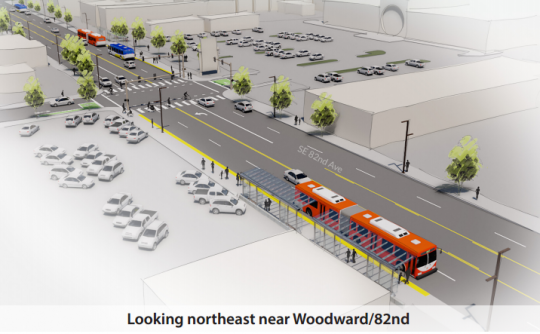
(Image via TriMet)
In any case, Beebe said the information may delay the project by years.
After the Jan. 21 memo, Metro canceled a planned Feb. 1 meeting where the project staff had been planning to ask the project’s steering committee for a final sign-off on the route. That conversation has been postponed until March 28, when the steering committee will meet to consider various major departures from the previous plan.
“It’s the first type of BRT in the region; we want to get it right, and we want to get something built that makes people’s lives better,” Beebe said. “I think it’s good when a project really takes some more time to really explore what the options are.”
Six alternative options for the project
Part of the reason to change course is that the Powell-Division project has been hoping to get dollar-for-dollar matching grants from the federal Small Starts program. That could bring in up to $100 million.
But getting that federal grant requires the Powell-Division project to be more attractive than other grant applicants around the country. And Beebe said that a project that wouldn’t generally make transit faster isn’t likely to get federal transit funding.
Advertisement
Instead, the project faces several options. Here are the ones being discussed so far, as described in a document that was circulated to project steering committee members this month. (Update: here’s a slightly revised version of the document released Friday.)
The project could scrap its aspiration for federal funding and just improve bus service on the #4 and the #9.
The project could save some time by further reducing the number of bus stations along the route, though this wouldn’t save enough time to make buses travel faster than they do today.
The project could spend vastly more money or political capital and create dedicated bus lanes either by knocking down buildings along the corridor or by dedicating existing travel lanes to buses only. A few notes on this scenario:
• Though this memo lists “bicycle” traffic as the first victim of “major impacts” from repurposed lane scenario, Metro says this phrase referred to the fact that people biking north and south would get longer red signal phases and to the difficulty of fitting bus lanes into the corner of 82nd and Division.
• The actual primary impact of this scenario, of course, would be that it would increase auto travel times.
• The project has never examined the possibility of a freight-and-bus-only lane, so that’s not considered here.
(Update: The version of the document released Friday in response to this story simply warns of “significant impacts to traffic” — though that seems to imply that people in buses are not “traffic.”)
The project could create bus lanes on a few key portions of the route. This, too, would be far more expensive and/or politically difficult.
The project could break into two phases (each of which might go in for its own Small Starts grant) first making changes to Division east of 82nd and then making changes to 82nd and Powell west of 82nd.
The project could break into two phases, first making improvements to Division and then making improvements to Powell.
The direction of the project from here will be decided by its steering committee, which includes citizen volunteers, advocates and public employees.
“We are definitely not coming to the table with the answer,” Mros-O’Hara said.
Heidi Guenin, an equity advocate who sits on that committee, said in an interview that it’s important to remember that the project has always been about land use as well as transportation, and that a two-phase approach — first inner Division, then inner Powell — would both prioritize poorer neighborhoods and also give the region a chance to apply anti-displacement policies thoughtfully.
“It’s running through some of the most vulnerable parts of Portland and of Gresham in terms of housing,” Guenin said. “If there is a viable project in the smaller corridors, I think that could make a lot of sense and would allow us to more clearly focus our money on the places that really need it.”
On the other hand, she said, there’s also a risk that the second phase of the project might never be built — which would reduce the current pressure for 82nd Avenue or inner Powell to be rebuilt from highways into streets and to pass from state to city control.
“This stuff has to get figured out,” Guenin said. “Maybe not in this timeline. But soon.”
— Michael Andersen, (503) 333-7824 – michael@bikeportland.org
BikePortland can’t survive without subscribers. It’s just $10 per month and you can sign up in a few minutes.


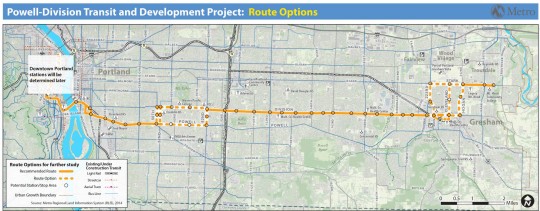
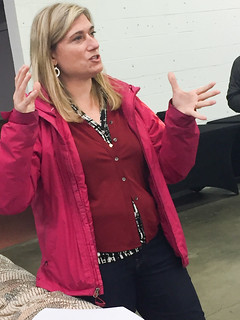
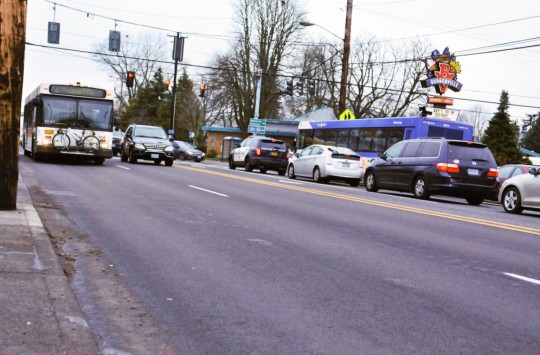
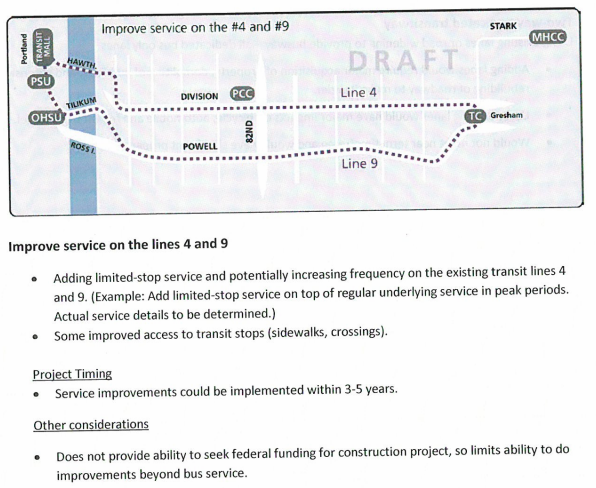
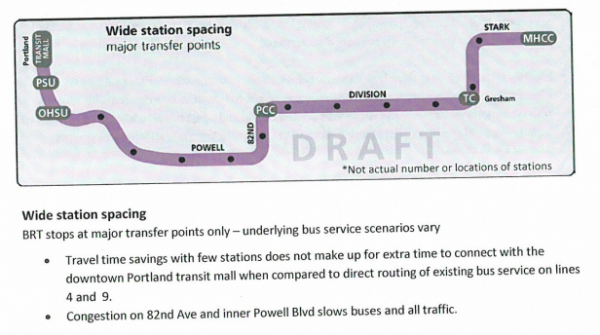
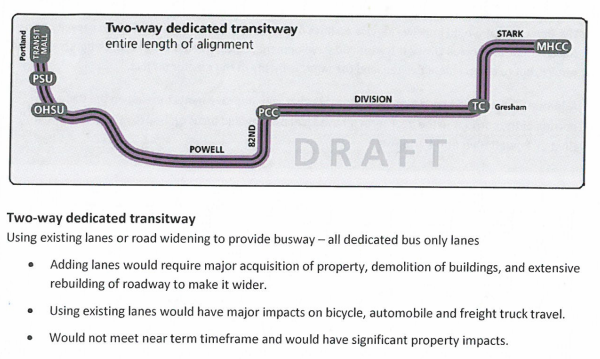
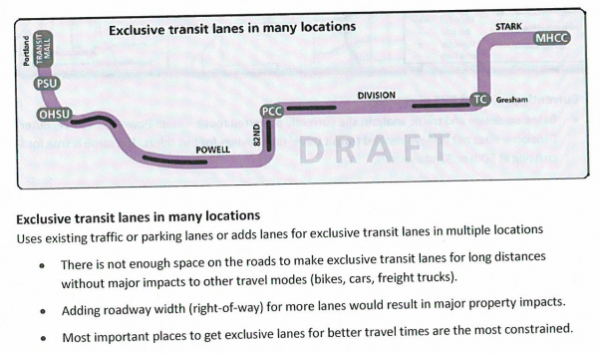
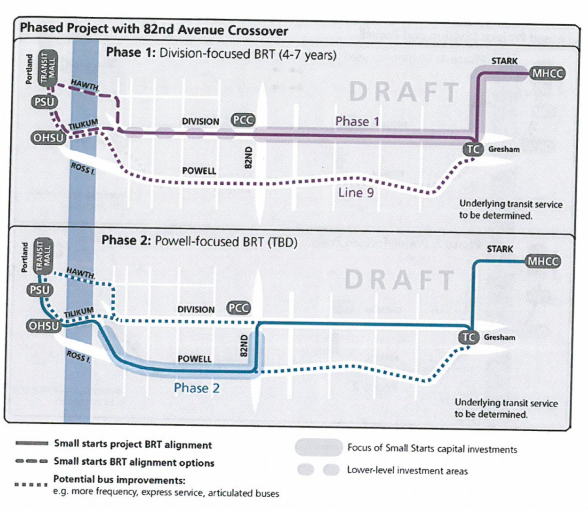
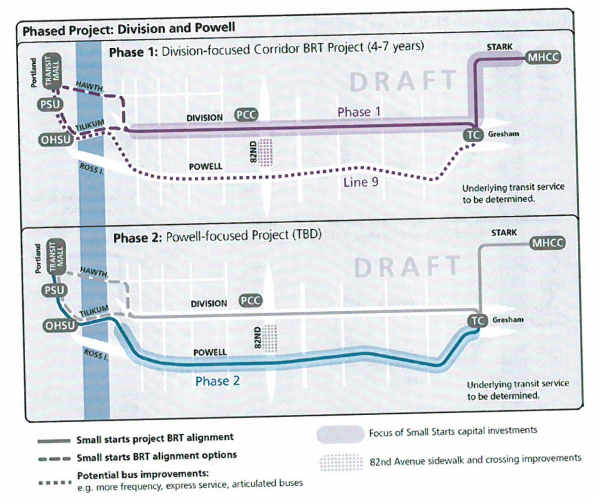
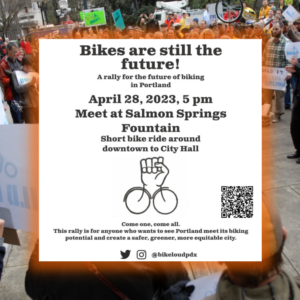
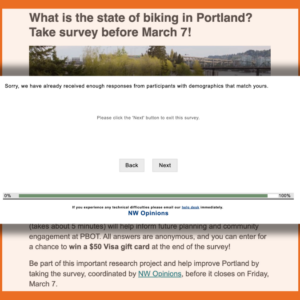
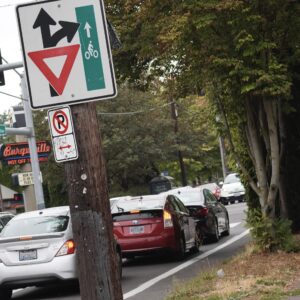
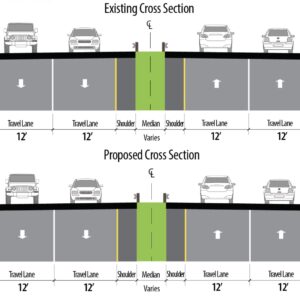
Thanks for reading.
BikePortland has served this community with independent community journalism since 2005. We rely on subscriptions from readers like you to survive. Your financial support is vital in keeping this valuable resource alive and well.
Please subscribe today to strengthen and expand our work.
ODOT knows protected bike lanes
I don’t see the point of calling something BRT if it doesn’t have a dedicated lane, because it clearly won’t work. Since they were arguing about if the bus would be allowed to stop in the lane rather than pulling out further delaying travel times on 82nd I am not holding out much hope for this project being worth using.
It’s definitely possible to improve bus service without a dedicated bus lane using signal preemption, pre-boarding payments, etc. Those things work! But not nearly as much as using them in combination with a dedicated bus lane, no.
They could do those things today; no need for a new “line”.
Yes, and we should be doing those things. But that doesn’t make it “BRT” – people seem to forget (and Trimet/Metro wants us to forget) that the “RT” stands for *rapid* transit.
Well it looks like TRIMET did the right thing…pulled the “stop” cord to see about getting this project back on route to its original objectives.
Yes – this is the same “problem” or “opportunity” that CTRAN will fully experience as its The Vine “BRT” opens this summer to replace the #4 / #44 routes in Vancouver.
CTRAN and the City of Vancouver [plus Clark College] were not able to muster up the effort to implement any sizeable dedicated lane sections along the project route…even on Fort Vancouver Way. Other than the time savings from not crossing the I-5 Bridge and pre boarding payment – I have my doubts that the new service will be rapid.
Perhaps TheVine will more of a “BLT” project – Bus Long Transit due to the much nicer rail style coaches the project will provide. BLTs seem to be the new BRT these days for many second tier urban communities.
Fixed it for Metro:
Coulda seen that coming… This project has been doomed from the beginning ever since they decided not to affect parking or car capacity. The idea that we could have “designed our way out of those chokepoints” is laughable. This project should have been light rail, but in trying to save money, we really just ended up wasting money on the futile pursuit of improving transit while not affecting SOV driving at all. The only reason the bus is slow is because of all the cars. Remove the cars and the bus improves.
I seriously hope that Metro and TriMet take this project’s failures under serious consideration when deciding upon BRT vs LRT for the SW Corridor project.
Agree on all points BUT, the REAL primary reason the bus is slow is trimet coddling riders. Have you been on the 15 lately? For large stretches, the stop are LESS than two full blocks apart. And in the morning, it stops at every single one of them. Fewer stops would yield more efficient stops and better throughput. Just clarifying.
That’s true too. Plus, eliminating stops costs nothing.
During rush hour, buses could alternate stops, don’t even need to eliminate stops. So Bus A stops at #1, 3, 5, etc., while Bus B stops at #2, 4, 6, etc.
For the 15 some buses are already short runs that skip some of the outlying stops. Ignoring those stops at peak you have service every five minutes. Cutting that to every ten minutes is a substantial service reduction. I’m not sure you’ll improve travel times by 5+ minutes to make up for it. As an alternative you could pick the busiest stops every quarter mile or so until you get downtown to be ‘express stops’. Instead of bus A stopping at 1,3,5 etc…and bus b stopping at 2,4,6 you could have bus A make every stop and bus b only make the ‘express stops’. It would give you a better chance of improving travel time, at least for those willing and able to walk a quarter mile.
https://trimet.org/schedules/w/t1015_0.htm
So BRT is cars, huh? Clever.
If you want to think big- consider that we could just take a street (maybe 1 block over) and say this street is now BRT only and close it to all traffic. There is a lot of public right of way. We’re only considering 2 streets instead of the larger picture here. Because residents want to mostly keep the status quo and politicians want to keep them happy.
You would need to change the signals, or add them. Plus, all the destinations are on Powell or Division.
Then again, I would volunteer my street to be local traffic only with frequent bus.
When it was a $50 million project and outreach was done at SE Uplift I said we needed dedicated ROW to 82 nd to make this work. When they came back at $150 mil I said the same thing. Always…not enough $$ for it.
Please, can government transportation agencies start listening to feedback? I am getting tired of saying I told you so.
In Metro’s survey for the SW Corridor, 66% of people prefer light rail over just 17% for BRT. Let’s see if TriMet and Metro listen to feedback this time. We certainly don’t need a repeat of the Powell-Division project for SW.
The cost of light rail over better bus service is outrageous. Light rail as installed by TriMet is an utter failure when it comes to getting people to work on time. Scrap the rail, build BRT with dedicated ROW and bring into service bus with amenities people want. No more coal powered light rail.
I think that the point here, and this project is a fine example, is that it’s too easy to whittle BRT projects down to uselessness. Rail is harder. In a perfect world I’d agree with you but if BRT worked we’d have it all over the place.
The way most people compare the cost of light rail to bus makes no sense. The only way to accurately compare the two is to:
1. Factor in the cost of acquiring a new right of way for a two lane dedicated bus line.
2. Factor in the cost of paving and maintaining a new two lane dedicated bus line
3. Factor in the difference in long term maintenance and replacement of the vehicle fleet. Busses last 20 years at most, as far as I know ALL light rail trains that have ever been bought are still in service.
4. Factor in the significant cost of operator per passenger ratios. Human staffing makes up the bulk of transit costs. A single operator can carry many more people on a train rather than a bus.
5. Take into account the dozens of other factors. Safety, rider perception, city image, property development value, carbon impact etc….
I think once you add all of these up there is a very compelling case for light rail.
The important comparison is the staff costs. Everything else gets amortized into insignificance.
The problem is, “BRT with dedicated ROW” approaches the magnitude of capital costs for light rail, unless you have excess pavement capacity available (which is rarely the case where high-capacity transit is warranted). ROW acquisition, pavement suitable for heavy bus traffic, relocating utilities for road rebuilding, etc., are all necessary if you want truly effective BRT. To the extent you cut costs on these, you reduce the project’s BRT-ness.
No — even with dedicated ROW, BRT is still much cheaper. LRT vehicles are ~10x more expensive, need overhead catenary, require extensive signaling, require an expensive maintenance yard, require power substations, and of course require tracks to be set into the ground (including switching).
g CO2/passenger mile
single occupancy car trip 371
transit bus trip 299
average car trip 235
light rail trip 202
walking 37
cycling 21
http://www.reconnectingamerica.org/assets/Uploads/publictransportationclimatechange2010.pdf
So… if I have a choice to drive (with a passenger), or take the bus, and I want to minimize my CO2 emissions… I should drive?
portland’s bus and light rail system is more heavily used so the numbers are better locally.
Ok, with two passengers should I skip the bus and drive?
H, K, If you are going to drive then I would suggest you use an EV charged with renewable RECs.
https://www.youtube.com/watch?v=fcZWZhUozr4
My understanding is: yes, but not at rush hour in Portland. Very few things in the world are more all-around efficient than an extremely crowded bus … which is of course why it would make so much sense to make high-capacity buses a highly desirable mode of transportation on inner Powell.
Extremely crowded cars are relatively carbon-efficient too, though.
Well, I don’t want to drive, but when I see numbers like those, what else should I do? I think there is an illogic in the way they are generally presented (not your particular presentation) that would lead people to conclude they could actually emit less by driving instead of taking the bus. Which is just silly.
Michael — wait, what? It would emit less CO2 to drive when it isn’t rush hour? Hopping on the bus (with my two friends) would somehow emit more (unless it were rush hour, in which case the calculus gets reversed)? Does that really make sense?
To minimize carbon footprint of the trip you should hop on the bus that’s already running, but not lobby for increased service.
They carry 4x the passengers and last 4x longer, so they are a deal at 10x the cost.
Source? A Type 5 MAX train has 144 seats. A King County metro articulated bus has 56 seats. That’s about 2.5x, not 4x. Lifespan of an LRT car is 30 years (the type 1 cars are EOL). For a bus, it’s more like 15.
Even if you somehow managed to get the vehicle cost to add up, rail costs go well beyond the vehicle. Signaling, rails, substations, maintenance yard, catenary, switches, crossing gates — not to mention the cost to design and maintain of all of that stuff. Can you cite a source that claims that LRT is cheaper to build than BRT? I haven’t seen one — that’s why in these days of reduced federal funding, many (including TriMet for Powell/Div) are looking to BRT. People like rail, but it’s expensive.
You may have some good points in there but if you’re measuring MAX train capacity by counting seats…..well, have you ever been on MAX on a weekday commute? There’s often twice as many people standing as sitting for a good bit of the route (much higher % than can stand on a bus).
LRT vehicles are typically configured with more standing room, and they handle crush loads much better due to the extra doors. Peak capacity is closer to 3-4x when you count standing room.
And you are forgetting to factor in operator costs, which are huge. A single driver of a 2-car MAX train vs. 4 bus drivers has a huge impact on operating costs. Light rail makes sense for high-capacity corridors, and in those situations it will save money in the long run. We can debate the merits of LRT on Powell by looking at projected ridership numbers.
First cost is a poor way to evaluate any two choices. Life cycle cost, with a common period is better. Factoring in costs and benefits beyond operation and maintenance would also be a better evaluation of what it costs us, the users and taxpayers.
http://www.vtpi.org/railcrit.pdf
http://www.vtpi.org/blw.pdf
http://www.vtpi.org/crit_econ_eval.pdf
You can add more cars with light rail depending on the system. Many of San Diego’s are 3-car trains for example, with capacity for over 100 per car (300+ total). Downtown Portland’s short blocks wouldn’t accommodate 3-car trains, but if you moved them underground…
“No more coal powered light rail.”
The Clean Energy and Coal Transition Act will phase out coal power in Oregon by 2030-35, which I suspect is not long after any new light rail comes online – and certainly a short period in the context of a LRT lifetime.
Although still preferable to SOV, I think BRT running off Trimet’s current biodiesel, going up and down the transit corridors all day, is not a good alternative to electricity.
And for PGE users it’s going to be largely phased out in a few years when Boardman shuts down. There is also some possibility that Boardman can be converted to biomass which has the potential to enormously decrease the CO2e of local power.
The coal plants are being converted to natural gas/methane. substantially cheaper than coal and much cleaner. Of course the methane build up from the antarctic and arctic will be getting to lethal levels before MAX service is put in on Powell.
We need to be looking at this at more of a macro level instead of just trying to design our way around particular congested intersections, etc. The big picture is, much of our city’s east side, particularly inside of I-205, is built out. That doesn’t mean it won’t get more dense — there will be lots of redevelopment, but it will pretty much all be happening on existing taxlot footprints. The point is, our transportation rights-of-way on streets like Burnside, Stark, Belmont, Hawthorne, Division, Powell, are pretty well defined and are not going to change. The question then, is: what’s the best use of this fixed amount of east-west right-of-way?
Shouldn’t the proportion of fixed right-of-way by mode reflect our transportation hierarchy? Leaving alone the question of bikes and peds (just to simplify), shouldn’t we be prioritizing the mode that carries up to 86 people in a single vehicle rather than having it endure the same delays as SOVs? People who chose transit for whatever reason — because they can’t drive, because they’d rather read a book or catch up on news/email/social media during their commute, because they feel good about commuting in a socially responsible way — shouldn’t these people be given positive reinforcement with a better service? Shouldn’t we be looking for ways to encourage MORE people to choose to commute this way? Because right now our streets are evidence that we live in a city that values SOV capacity and private automobile storage over good, reliable transit service — to say nothing of protected bike infrastructure and all the usual stuff people go on and on about in these comment threads.
“An advanced city is not one where even the poor use cars, but rather one where even the rich use public transport.” – Enrique Peñalosa
I disagree. Most of those streets have 18-20 feet of very expensive road space dedicated to storage of “stuff”.
Isn’t this obvious? If you don’t give the bus priority (i.e. exclusive lanes) in the places with heavy traffic, it’s going to remain stuck in that traffic.
This is what I’ve been ranting all along. BRT is a huge win on paper- it costs less and provides equivalent (or even better!) service than light rail. But it doesn’t work politically- there are too many ways to neuter it. There’s a huge difference between BRT and bus service, but BRT gets chipped away until it is bus service with different branding.
It’s hard to do that with light rail. You can require too many at-grade crossings but it doesn’t have to compete with car traffic or ODOT’s machinations.
If this project had already been compromised in your view, it’s certainly a good thing that Metro/TriMet/etc are hitting the brakes right now rather than proceeding as if everything is OK! Just sayin’.
Also, I don’t think light rail is actually immune to this problem. What do Portlanders call a light rail line that isn’t rapid because it doesn’t have a dedicated travel lane? A streetcar.
In addition to MAX not having fully dedicated ROW Downtown, it’s also neutered by having ridiculously short stop spacing (ex: Kings Hill, PGE Park are 1.5 – 2 blocks apart)… but yes the street car is a great example of what Powell-Div BRT would have looked like.
MAX does have dedicated ROW downtown.
The problem is grade separation. I consider ROW to not only be the “lane” but the freedom from pedestrian and car crossings.
Monorail!
In North Haverbrook, the streets are filled with electric velomobiles.
That’s what put them on the map!
This is what most of us armchair engineers have been saying the entire time. Glad that the real engineers are finally admitting their mistakes. 🙂
Yeah, I know I’ve commented on it elsewhere too.
I’m tempted to write up the whole LA 720 debacle, which is a perfect lesson in BRT failing in this way.
The project “answers” seem to have ignored the amount of people transported as opposed to a singular bus versus car versus truck. Since more people fit in a bus, dedicated bus lanes could feasibly transport more people in less time (because the buses could drive without congestion) as compared with the amount of people in single car (in stop and go traffic).
Perhaps the question is: which people do you want waiting more? People in a bus? Or people in a car?
“What we’re all finding is that having a BRT that is mostly sharing the roadway is extremely complicated,”
That’s because BRT on a shared roadway isn’t BRT – it’s a gimmick.
No, it’s an express bus. Which we need here too. But express buses can be implemented for essentially no cost. Just remove half the stops. Even better: implement rush hour parking bans so the buses have a dedicated lane during peak hour! Also can be implemented for nearly zero cost.
The only person talking about “express buses” is you. This article is about BRT.
No, my point is if we’re going to go out of our way to implement an expensive BRT project that doesn’t affect car drivers or auto capacity, then why not just have express buses that are essentially free?
We actually used “express bus” above and in the previous article. For this project, we almost always put “bus rapid transit” in quotes.
The federal standard for large bus rapid transit grants (the New Starts program rather than the Small Starts one) is that a line needs to have at least 50 percent exclusive bus lanes. Using “BRT” for anything less than that is controversial.
Metro and TriMet have chosen to do so, but BikePortland has not, except within scare quotes.
Exactly, Todd! It’s depressing (as well as depressingly predictable) that even one person (much less *many* people) working for Metro or PBOT would even *think* of calling this proposal BRT. The TRUE definition of BRT involves dedicated ROW for 100% of the BRT line’s length, although I’ll even accept the watered down “over 50%” definition. BRT also involves many LRT-esque aspects that Metro and PBOT always overlook (and 1950s-mobility-obsessed ODOT obviously goes without saying).
What IS encouraging is seeing all the great comments from folks who understand these issues far better than our leaders do–as well as apparently many folks who get paid to work on transit issues. They need to keep hearing from us. If enough of us offer real solutions–with good explanations of long-term benefits and costs–I really think they’ll eventually listen. 🙂
What I can NEVER understand, though, is why our planners and elected leaders rarely seek the advice of great urban/transportation planning visionaries throughout the planet, including our own Jarrett Walker–or many great folks just down the street at PSU. I really hope that ALL of our decision-makers hear the legendary Janette Sadik-Khan at either Mission Theater on 3/23 or at Powell’s on 3/24. Granted, they seemed to learn absolutely nothing from Mikael Colville-Andersen’s visit in October 2009: the apex of the Columbia River Crossing debacle.
Anyway, back to Metro/Trimet/ODOT’s worthless “express bus” proposal: as some have pointed out, it’s true that when ALL very-long-term costs (including nearly impossible-to-measure “perception,” etc) are factored in, LRT looks incredibly compelling. I’m not saying that LRT is or is not the answer, but I wish that they’d consider *actual* BRT for this corridor. I’m just glad that they’re shelving this deeply flawed plan for now; it would have killed all hope for true BRT in the future.
This reminds of the “priority triangle” that is supposed to help make these very decisions: Peds>bikes>Transit>freight>SOV. Except when you are acturally trying to plan a really transit projects then it is sorry peds and bikes, no impacts to freight and SOV and transit is status quo or worse! Please take a lane and convert it dedicated transit. Or reconsider trains.
I want a subway.
and a tuna melt with a cap over I-5 by the Rose Quarter
All I want is a pony.
I guess I shouldn’t be surprised that the original plans did not include at least one dedicated bus lane. After all, this is the city that believes that calling a street “Bike Boulevard” or “Neighborhood Greenway” is a substitute for infrastructure. BRT can only be sustainably “rapid” if there are dedicated lanes for the buses.
I truly believe there needs to be an east-west Max line across the Southeast and Northeast. A bus lane, which won’t even be a bus lane in most places, is just not very forward thinking.
It’s unfortunate that the majority of SE really lacks any form of rail transit. I live in almost the exact middle of SE (inside of 82nd) and am 1.5 miles from three rail lines, but none are really reasonably walkable from home. LRT down Powell would really fill that gap.
Trimet capital projects department, which sucks about $10 million a year out of the general fund, just isn’t thinking big enough
Light rail to Mount Hood!
Think of the development possibilities!
Stacey&Witbek is ready to go!
KEEP THE MONSTER ALIVE!
Maybe if we had light rail to the mountain, people wouldn’t be driving around with those ridiculous studded tires all winter. 😉
Lol!
I am of course joking about MAX to Mt. Hood, but I do seriously think that ODOT needs to be looking into a one-seat Portland–Mt. Hood frequent service shuttle bus during the peak of the ski season that is funded by the ski resorts. Current options involve three buses and a three hour journey. Effectively, impose transportation demand management on the ski facilities that are causing the traffic congestion on 26. They might even get more customers out of the deal!
I know you’re not serious, but in truth those studded tire cars are the ones that rarely, if ever, make trips up the mountains.
Hah! That headline made me laugh-choke on my tea! 🙂
Once again, very thankful for the reporting here. I’m all for the “better and more 9 & 4!” solution. Also the ‘sacrifice a car lane to bus rapidity” solution. The idea of an actual BRT on Powell with dedicated bus lane makes me giddy.
Does the analysis on traffic impact take into consideration that with a dedicated bus lane and faster bus travel time, BRT can achieve enough mode split to minimize car traffic congestion? If the the analysis assumes that the number of cars on the road stay the same, then of course taking a way a lane will significantly impact traffic congestion.
Also, I wonder if the project team has looked at how many people can be moved through the Powell-Division Corridor instead of how many cars. Sure, with a dedicated bus lane, traffic may get worse, but that might actually increase the number of people traveling through as more people find taking the (real) BRT is better than driving.
The results of any analysis depend on the input and the assumptions used by the analysts. Until planners and engineers are willing to prioritize moving people instead of cars, transit and active transportation projects will continue to be dwarfed by this perverse obsession with preserving of auto capacity.
Instead of using 82nd as the job route, what about either looking at options along 205 to make the job or even make part of the MAX tracks multi-transit use for that short section? This would shave several minutes off the route without impacting existing streets too much.
I think the intent of routing the BRT through 82nd was to use BRT as a catalyst to spur more development and density along 82nd. A route along 205 can’t really offer the same land use opportunities.
But a bus stuck in traffic is not a great catalyst for development.
How about adding swing gates at a few more MAX crossings and stop sign enforcement at Ladd’s Addition to see if those would help speed up bus traffic in the Division and Powell corridors?
I think it is actually quite simple. The only way a BRT along Powell can work is by removing an auto lane. Period.
Well, you could go under (subway) or over (monorail), but those are radically different projects.
Yup, and note that every other major city in the Pacific Northwest (all 2 of them) have elevated rapid transit. Vancouver’s is huge and driverless and being expanded right now. https://en.wikipedia.org/wiki/Evergreen_Extension
As I said before a “zipper tunnel” the only way to go. the neighbors won’t notice the noise.
This corridor should be LRT, and Trimet and the region should shelve the project until they can fund a proper rapid transit line.
– LRT would tie in with existing tracks: the orange line on the west end, the green line at I-205, and the Ruby yard in Gresham. Building LRT on Powell opens up several opportunities: re-routing the Green line on Powell for faster trips downtown from Clackamas. With the re-routing of the Green Line, a new line can be created between the airport and Clackamas TC. This does two things: 1. relieves congestion on the busy I-84 MAX line and the Steel Bridge. 2. Enables one-seat rides from Clackamas to PDX and to downtown.
– Increased operational efficiency for the Orange line. The new Powell line would enable trains from the Ruby yard to get to Milwaukie faster.
Starting on the west end, the line would T off of the Orange line just after Clinton, and travel on the median of Powell until just before 26th, where it would run elevated to 39th. Yes, elevated running is expensive, but only two elevated stations would be needed for the entire line (26th and 39th). From there it would median run on Powell until I-205, where it would T into the existing Green line tracks. The Powell line would continue north and use the existing Division stop before turning east below the grade of Division, and re-emerging just after I-205, where it can run in the median all the way out to the terminus in Gresham. There would be a small spur line at 202nd using an existing ROW so trains can access the Ruby yard from the south.
The beauty of this plan is that it can be built in 3 phases if needed. The Clinton to I-205 segment, the I-205 to Ruby segment, and the Ruby to MHCC segment. With strategic use of surface running and elevated segments, Powell can be kept at 4 lanes (although turning options would be restricted in many segments).
An example of elevated light rail:
http://www.alexblock.net/blog/wp-content/uploads/2013/08/VTA-San-Jose-1-1024×450.png
That is perfect! Who do I lobby to support Chris I’s idea?
This is a terrific idea and would serve the neighborhoods far better than an underfunded BRT line.
Yep, same rolling stock is a huge advantage. Among the other advantages of a MAX line through there.
This project is like Monty Python’s parrot. Trimet keeps telling us the project is alive.
Without a radical change in direction (more $$ or ODOT finds religion), there is no way it can work.
I think this (MAX line from Orange Line east along Powell and Division to Gresham) makes the most sense. How would it be funded?. I imagine it would cost around $1.0 to $1.5 billion dollars?
My estimate is around $1 billion for full build out, but the Feds would cover half of it. This is what Trimet was trying to do with the fake BRT project on Powell. If they could get Federal funding, it significantly reduces the local dollars needed.
The section between 17th and I-205 is clearly the most expensive, due to ROW restrictions, but it is also the most important. This should be the first phase. I-205 to Ruby would be cheaper per mile, as it would be built using the excess width on the Division ROW, and would be all surface running.
Portland really, really needs to double down on light rail.
We can see how congested traffic is getting, and it will only get worse. Buses are very important, but they get slowed by congestion just like cars. Our roads are usually not wide enough for bus-only lanes. Bikes are important, but consider our weather. There is a real ceiling on how many people will put on foul weather gear and pedal 10 miles in 35F rain.
Maybe cut it down to about 3-5 stops in that 13 miles. And take a couple lanes off of powell, because there’s a big highway for cars about one mile over.
Okay, I mostly lurk, but this is one of my pet peeves. Powell and 84 are 2-2.5 miles apart west of 82nd, farther apart on the east side. And with only 205 between the 181st and 43rd exits westbound, 84 is not a practical option if you’re going west from Gresham to anywhere east of Hollywood.
At 82nd, Killingsworth/30B is closer to 84 than Powell. That’s another good corridor for future transit options, but imagine asking people driving from Parkrose to Concordia to take 84.
Fine. How much of the traffic on Powell is going from Gresham to across the Ross Island bridge? Is the traffic in the second set of lanes not induced demand?
That’s a good question, Eric, and one I don’t have an answer to. I know from living in that area for several years that there is already a lot of traffic on Holgate going to Ross Island via Milwaukie Ave in an attempt to avoid Powell, and the two lane portion of Powell between 205 and Gresham is quite busy, even with four lane Division nearby as an alternative.
My point is, if four lanes induces demand, then it’s been induced already. If you remove half the car capacity of Powell, that traffic is not going to magically jump to 84; it’s going to Holgate, Division, and a host of other east-west two lane roads in the area.
This only works if there are LARGE park and ride lots at these stations. I live about a mile from a MAX station in Hillsboro and 1.5 miles from another. I use the further MAX about 95% of the times I use MAX since it has park and ride. My neighbors won’t use MAX at all. Asking them to walk/ride a mile might as well be asking them to scale Mt Hood in flip-flops.
I don’t know what changed in America in the last 30-40 years to make it nearly impossible to “think big” about infrastructure. We’ve had waves of democratic and republican ascendancy, higher then lower taxes, regional governments, growth boundaries, economic booms, busts, white guys then slightly less white people in government and yet here we are in 2016, unable to figure out how to move people in a suburb of Portland.
My knee jerk response is to blame leadership for not being leaders, just following the will of the loudest voices which will always be NIMBY types. But weren’t they the ones which saved us from the Mt. Hood Freeway? On the other hand, you have to break a few eggs to make an omelet, right?
The BRT Powell/Division project as conceived was doomed from the start because they didn’t actually want to do the hard work of disrupting property owners or prioritize anything, really. In the end that’s what all transit infrastructure projects inherently do; show favoritism for transit over other uses because it serves more people, better.
Sigh….this all leads me to a very dim view of the future and current political rigor mortise we find ourselves in. 🙁
There’s not point in “thinking big” since there is no money to implement even modest projects.
The federal gas tax has been stuck at 18.4 cents per gallon since 1993. During that interval the construction cost index has risen by 70 percent. So building a new bike path, a traffic signal, or repaving a street costs 70 percent more than it did 23 years ago, but there is no more money than there was then.
Add to that all the new mandates: ADA compliant curb cuts, new traffic signs with larger letters, fish-friendly culverts instead of the old ones that cut off spawning habitat, etc. All those are good things, but they cost lots of money and have reduced what’s available for other purposes.
Besides that, thinking big generally upsets too many constituencies. Take the CRC for example. Washington legislators didn’t like it because it included extension of light rail to Vancouver and included separated, protected bicycle facilties. Bikeportland readers hated it because it included freeway expansion. Fiscal conservatives hated it because it included too much “mitigation” stuff, including bike facilities, wetlands, etc. Commuters hated it because it would include tolls.
There’s not much point in thinking big when we can’t even do little stuff. Except for stop sign enforcement at Ladd’s Additon and swing gates to make Max lines “safer” for bicyclists.
Thanks Kittens. Totally agree. I guess it’s a lot easier to talk about how things won’t work (parking! property! right of way! the businesses! it costs almost what a new freeway would cost!) rather than committing to something big.
And it’s not like those same pressures did not exist in the past yet we managed to move forward.
Dare I say it is a result of hyper-public involvement in all stages of a project which results in sub-optimal projects?
they could have kept the BRT on division and made a dedicated lane if they hadn’t removed the 4-lane configuration on the inner sections below 60th…
and they could have their dedicated lanes on 82nd if it wasn’t controlled by ODOT… we could all have a lot of nice things if it wasn’t for ODOT…
After Trimet and ODOT get done with it it will be just painting with no structure difference but it will still be a #200 million dollar rat hole.
Early on in the public outreach process half of the people surveyed were interested in a MAX for at least part of the corridor. No substantive information was given on LRT, nor was there any serious consideration of it. Improving bus transit is nice, but it will do very little to compete with SOVs. This project should have included the possibility of light rail for at least the section from SE 11th to I-205, which would have an effect on numerous bus and MAX routes in SE/NE. The planned narrow Powell corridor will have very little effect on other lines. It really was doomed to be insular, hence fairly worthless, from the start.
the TCRP 2007 Report #118 on BRT Practitioner’s Guide (aka BRT 101) bluntly states that a project is NOT a BRT project if it it “just [an] express service along a bus lane or busway.”
http://www.tcrponline.org/PDFDocuments/TCRP_RPT_118.pdf
TCRP PRINCIPAL #4:
“BRT should be rapid.”
“It should operate on separate rights-of-way wherever possible and on wide, continuous, free-flowing streets where separate rights-of-way are unavailable or removed from markets. Wide station spacing (except in downtown areas) is desirable. Transit preferential treatments such as exclusive bus lanes, transit signal priority (TSP), queue jumps/bypass lanes, and curb extensions are desirable.”
I’m thrilled that Trimet is taking a step back to figure out what to do. How many government agencies around the country would have kept going simply to expand their budgets, etc, leaving their taxpayers with a boondoggle?
I also love Chris’ LRT idea, above.
I really hope this BRT debacle causes TriMet and Metro to rethink their decision to go with BRT over LRT.
It doesn’t matter. Without dedicated ROW, neither can work. That’s what they need to rethink.
Not if it was elevated. The footprint is pretty small, about the size of the center turn lanes and medians already present on Powell. And the supports are spaced out enough to still have turn pockets.
Light rail has massive up fron capital and business costs. People forget the business that suffers during construction that literally rips up existing streets. Brt construction is minimal and relatively cheap. Electrifying the brt gives you the best of both worlds.
Going on farther, putting a protected bike lane next do the brt is even better. People know that but instead want to cling to their fantasies. One camp wants to have super expensive rail everywhere, and another wants their cartopia.
So 82nd is the problem, and all plans continue with 82nd?
I don’t understand the fascination and reasoning with 82nd being the crossover. What’s wrong with the 50 or 52 which would give direct access to Warner Pacific and Franklin HS which are much bigger transit orientated destinations than a small shopping mall and a strip mall.
What about bus only streets by the 205 off ramps between Division and Powell?
I’m all for spiffing up 82nd, it’s my hood – but it simply won’t and improve travel times. At rush hour traffic moves at a walking pace through here.
Other than the whole thing being a half-@ssed plan to begin with (no dedicated lanes) keeping it on 82nd is the biggest problem.
Elevated light rail down the middle of Powell Blvd would not only be awesome, it would also be a great response to the failed Mt Hood Freeway.
High Capacity Transit (HCT) without ROW is a fraud. Glad the plug was pulled on this project, but why did it take so long? How many miles of bikeways could have been built with the dough wasted on staff?
In heavily traveled corridors it makes sense to consolidate transit riders into larger vehicles, as operators are the cost centers of operations. Rail can accommodate more riders than bus, so the choice is pretty obvious.
I think Chris I is spot on re his suggestion of LRT out to the Green line via Powell. Doesn’t ODOT own all that parking on the south side of Powell east from 50th or so (except for my wife’s dentist office!) to around 82nd? So the challenge is between the existing Orange Line at 17th & Powell and 52nd, or less 2 miles. Elevated trackways seem to work in Vancouver BC; why not inner Powell. Beyond the Green Line, Division has enough ROW.
The BRT thing has always looked to me like a simple failure of nerve at Metro & TriMet. HCT on the cheap just does not work.
I may be wrong, but it doesn’t appear to me that they’ve “pulled the plug.” I think they’re just going to rebrand the project, spend lots of money, and try to convince us that it’s a good thing. Like WES that was originally supposed to carry 8,000 riders per day, but actually carries about 1500.
This is infuriating as resident of SE near Powell…and also having just spent time in Seattle where everyone was out in droves celebrating the new light rail stops all the way to UW with expansions under construction.
Not sure why these engineers don’t consider alternate traffic flows. 2 lanes of vehicles plus one of BRT in the AM running towards downtown, and vice versa going out after noon. Reduce down to one lane for the traffic heading the opposite direction in traffic. That would be the cheapest fix, although they really need to just muster up some balls and reclaim some real estate in the inner Powell area to make it work (like the closed-down Wendy’s?!), while also utilizing elevated tracks before the market drives it to be astronomically expensive. This project has been shot from the get go, as it seems they’ve always been planning on having the rapid bus sit in the congestion between Powell/26th and SE Milwaukie. Not sure how signals would ever fix that pinch point under the train overpass. I remember one gentleman on the Powell bus screaming one morning at 7:15 as we sat motionless under the overpass, “I pulled the cord almost 30 minutes ago! When can i get off?”
Ridiculous that they spent all that money on the bridge without a proper plan for buses to even access it.
This whole project has become absurd, mixing buses, whether 60 foot or 40 foot or whatever are still going to be delayed, stacked, and whatever. If one names the issue this line would have it.
Also, Beebe states this would be the first BRT (me: faux BRT http://transitsleuth.com/2016/02/11/transit-projects-faux-brt-a-summary-of-the-situation/) in the region. That is incorrect, the first faux BRT is being built on Fourth Plain which is in this region, at least it is in the metro area. There are also decades of experience to learn from in other regions to get this done right (Orange Line in LA is done properly). We should be looking at a good implementation of this instead of the completely broken and misguided effort that is currently on the board.
The solution is very easy: strike a lane from auto use (center or outter, both have been done) and enable that lane for bus ONLY use.
In almost every one of these transportation issues we have in Portland, the solutions are easy, the first step is to always remove priority from cars or remove the cars and enable a more efficient higher throughput capacity mode. Otherwise we might as well just get used to the auto-congestion, because that isn’t going to get any better, only worse.
I haven’t seen in action, but Eugene’s downtown bus service is in the outer lanes, with those lanes designated for buses or right turns only. Does anyone have a better understanding of that system, and if it would work?
10th and 11th downtown the streetcar lanes were recently signed to be right turn only for cars every other block. If you want something on an arterial, checkout the ‘rapid ride’ on Aurora in Seattle.
http://www.seattle.gov/transportation/aurora_rapidride_bat.htm
Experience in some cities has shown that without enforcement this sort of lane restriction won’t always be well respected. The novelty+allure of the empty lane is a problem. If you have a bus every five or ten minutes and the lane is mostly empty in Portland you’ll also get a decent number of cyclists. If the point is to make room for a bus to drive down a congested arterial at 30 mph even if cars are stopped in traffic cyclists going 10-15 mph in the same lane wouldn’t be desirable. Checkout how often people drive and bike in the transit lanes on 5th and 6th downtown.
You’re right; it is illogical. The numbers quoted above (if they’re right) are *overall* system emissions costs, including lots of near-empty buses running around outside peak times.
What matters for an individual trip is the incremental emissions added by your trip. If you drive, emissions (if you drove an average vehicle) would be 371gm/mi, so for 3 passengers about 124 gm/pmi.
If the 3 of you hop on the bus the incremental emissions are effectively zero, because you’re getting on a vehicle that’s driving anyway, and not putting another vehicle on the road.
So it’s still better to take the bus.
Pollution is systemic, not individual.
One other thing to consider, people. Powell is US 26, a National highway. Renenber, ODOT says that it’s “the main highway to Madras” and therefore, no bike lanes allowed on Powell. Would they allow elevated MAX on Powell? Keep in mind that NYC’s Airtrain to / from JFK Airport is elevated alongside a major Intersfate freeway corridor, which could be the model for elevated MAX service on Powell. If ODOT says no, then the MAX must go out Division, which is being rebuilt with new buildings along it at a record setting pace right now. A lot of that development might have to be removed for a MAX line. You can imagine the NIMBY screams under that set of circumstances.
Congratulations, GlowBoy! You are one of the few that understands this! How many times have you seen “emission calculators” that use system numbers as if they applied to individual trips? Have you ever seen one that did not conflate these?